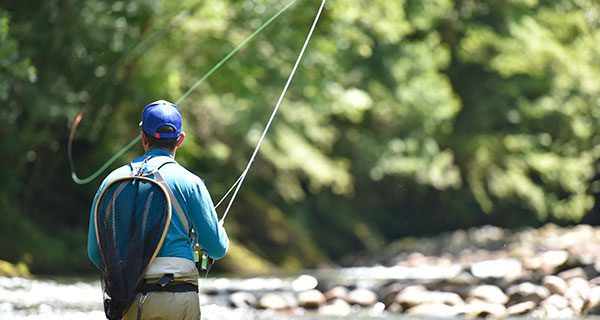Last month we spoke of the Cicada bugs and a cast to imitate the fly hitting the water and casting a big floating fly like a black popper, or something similar to the actual bug. This type of fly is going to dig into the water if you start your back cast while the line and fly are laying on the water, and that will overload the rod. Not only overloading the rod, it will also take a lot more effort to make the cast than necessary. After describing the cast last month, I mentioned there is a good way to make the next cast, and it starts with the spiral lift or corkscrew lift.
The actual hand movement is so small, but it’s amplified by the length of the rod. Small movements with the hand make a big impact on the rod tip, so start smaller than you think will work. To practice the lift, try pointing your finger up, elbow down (no rod in hand to practice) and palm about even with the top of your head. Start with a very small push of your hand toward the fly while making a very small circle starting from the bottom and going around to the outside of your body and back. Make the circle about the size of a baseball with your hand/fingertip. A right hander will make a counterclockwise rotation as your hand is moving forward about 6 inches toward the fly. A lefty makes a clockwise rotation. Pretend you are drawing a circle with your rod tip about 10 feet above your fly.
Like the speed-up and stop portion of a normal cast, use that concept on the acceleration of the circular motion you make with your hand AND the stroke of the hand toward the fly. When you are on the water, lift as much line as you can while getting your hand in the right position, then without stopping, push your hand toward the fly while making the small circle. If you lift and hesitate, the line will sag and lose tension.
The energized line that was created by your hand and rod movement will lift the line off the water and when it has reached the fly, start the back cast. So, don’t start the rearward movement until the leader/fly are lifted by the spiral.
Let the line movement, in the shape of a small spiral, move down the line to the leader. When it gets to the leader and then the fly, start your back cast. The tension on the line from the line movement helps load (bend) the rod on the back cast. Remember, this is not a lift, spiral and back cast with 50 or 60 feet of line out. You have to be at the belly of the line or at least at the start of the rear taper, towards the belly, because as Tom White would say, “The skinny line will not turn over the fat line”.
More online next month.
